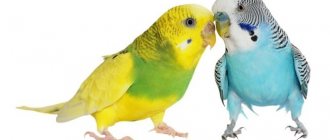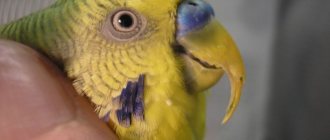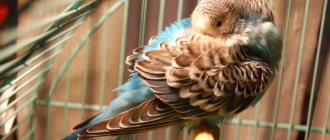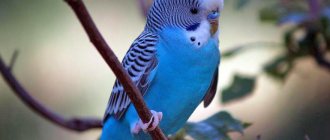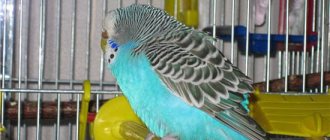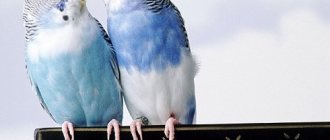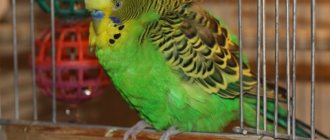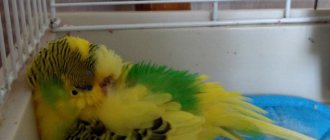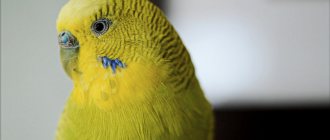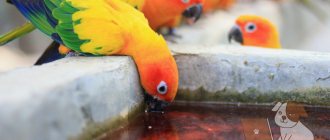Many lovebird diseases have similar symptoms that can indicate problems in the bird's body: restlessness, loss of appetite, lethargy, diarrhea, and so on. It is necessary to constantly monitor the condition of the birds in order to prevent disease. Today we will talk about the most common diseases in these parrots and how to treat them.
What do lovebirds get sick of?
The list of diseases that lovebirds can get is long. Most often they get sick from violation of living conditions, improper feeding, lack of attention, if you have one lovebird. Mild forms of the disease can pass without consequences, while severe ones lead to complications and death.
The most common diseases of these parrots are divided into:
- non-contagious - diarrhea, hypo- and vitamin deficiency, inflammation of goiter, gout, obesity, sore throat;
- infectious – salmonellosis, psittacosis;
- parasitic – helminthiasis, scabies mite, coccidiosis.
Lovebirds experience respiratory diseases of a cold nature - they are caused by drafts and hypothermia, keeping them in a damp, cold room.
When releasing a bird to fly, keep an eye on it. An oversight can result in injury, burns, or poisoning. Many house plants, pills, sharp objects and much more are dangerous for lovebirds.
Self-medication in case of illness in a lovebird parrot is unacceptable. Firstly, there is a high probability of making an incorrect diagnosis, and secondly, incorrectly calculating the dosage of the medicine. As a result, the bird will die not from lack of help, but from an overdose of the drug. Also, some diseases require surgery. Therefore, you cannot do without consulting a veterinarian ornithologist!
Prevention measures
- Keep food and water fresh.
- A newly acquired bird should not be immediately placed in a cage with other pets. Keep her separately for a month.
- You need to change the water and wash the drinking bowl at least once a day.
- Give the bird free rein, let it fly a little.
- Wash the bathing container thoroughly.
- When dealing with a parrot, never use paint, varnish, or insect repellent.
- There should always be activated carbon in the cage.
- Visit your veterinarian from time to time.
- Control the temperature in the room where the bird is located. The cage should not be placed in direct sunlight or in a draft.
Signs of illness
Treating lovebirds is a complex process. It is difficult for owners, especially inexperienced ones, to recognize the signs of the disease and often the doctor has to treat an advanced disease. In the first stages of illness, birds often behave as usual, and illness appears too late. Diseases in lovebirds progress quickly, and in the absence of immediate help from a specialist ornithologist, the parrot may die. Therefore, it is important to observe how the bird behaves and what it looks like.
What a healthy parrot looks like:
- feathers – have a slightly pleasant shine, fit tightly, not greasy to the touch;
- beak – symmetrical, curved at the right angle, golden or red;
- paws - without growths, spots and peeling, with glossy claws;
- body – without contamination in the cloaca area, with a thin layer of subcutaneous fat on the abdomen.
Signs that should alert the owner of a lovebird:
- blurred eyes, hoarse voice;
- lack of appetite;
- swollen belly;
- pollution in the cloaca area;
- detachment, the parrot sits ruffled.
Lovebirds have one peculiarity - when they feel unwell, their behavior changes dramatically. Keep an eye on the bird and notice in time whether it is too active or too lethargic.
If there are alarming symptoms, immediately show the bird to a specialist. If you have two lovebirds, then until examined by a doctor, the victim should be isolated in a separate cage.
Non-communicable diseases
Avitaminosis
Due to a lack of vitamins in the body, a lovebird may develop vitamin deficiency. At the initial stage of development of the disease, the parrot ceases to be interested in food and daily activities, becomes lethargic and depressed. His coordination of movements is impaired and trembling appears. If vitamin deficiency progresses, the bird's eyelids swell, pus flows from the eyes or nostrils, and convulsions appear with the head thrown back.
To help the lovebird, he needs to be given daily seasonal vegetables and fruits, fresh herbs, young branches of fruit and deciduous trees, berries, sprouted wheat and millet. In winter, it is necessary to add liquid vitamin complexes to the drinking bowl. Half-hour walks in the fresh air and sunbathing, but not in direct sunlight, will also be useful.
Enhanced feeding with vitamins is stopped as soon as the parrot recovers completely. A large amount of vitamin substances is harmful to healthy birds and threatens overdose with subsequent poisoning.
Gastrointestinal disorders
Due to low-quality, expired food or sour food, a malfunction may occur in the lovebird’s stomach. Disturbances in the gastrointestinal tract are also possible due to drafts, dirt in the cage, excess greens, lack of millet in the bird's diet, poisoning, and stress.
The first symptom of problems is diarrhea. Frequent liquid droppings of a lovebird lead to inflammation of the tissues of its cloaca. The parrot often sits ruffled in one place and does not eat anything. And if he does eat, after a short period of time he regurgitates the semi-digested food.
It is necessary to stop diarrhea with rice porridge or decoction. Greens and fruits, flax seeds are completely removed from the diet. Drinking water is boiled, cooled to twenty-seven degrees and potassium permanganate or half a milligram of Gamavit is added to fifty milliliters of boiled water. Water can be alternated with infusion of blueberries or chamomile. Treatment is continued for a week.
The bird's cloaca must be washed with a weak solution of potassium permanganate and lubricated with linseed oil. In advanced cases, the cloaca may fall out and dry out. If the bird starts to peck at it, it will cause bleeding. Without urgent intervention, the lovebird may die. To prevent the parrot from reaching the sore spot, you need to put a medical collar on it and urgently show it to the veterinarian.
If a lovebird leads a sedentary lifestyle, is overweight or has a monotonous diet, it may develop constipation - a blockage of the bird's intestines. In this case, the parrot cannot go to the toilet for a long time, and when it does, the piles of droppings are unnaturally large.
To help the bird, it is necessary to diversify its diet with fresh herbs, flax seeds, and oak bark decoctions. One crushed tablet of activated carbon per day or Vetom 1.1 can also restore intestinal microflora.
Diarrhea and constipation are not separate diseases. They are harbingers of serious diseases: prolonged molting, skin dermatitis, tumors, hyperthyroidism and others. If the lovebird's condition does not improve, only urgent veterinary intervention can help him.
Crop blockage
If you feed a lovebird with large grains like wheat, coarsely chopped vegetables, and dry food, then its crop will become blocked. The same thing happens if a bird swallows a bead, a part from a toy, or another similar thing. The parrot may try to regurgitate a foreign object or stuck food. If he fails, a tumor begins to grow at the top of the neck.
Symptoms of blockage include loss of appetite, shortness of breath, diarrhea, wheezing when breathing, and foul-smelling mucus coming from the mouth. Gradually the tumor increases, the goiter becomes inflamed. At the first signs of illness, you need to see a doctor. Surgery may be required. If the parrot is not helped, the goiter will expand, the tumor will go deeper and the parrot will suffocate.
Vaccinations for lovebirds
Birds also need vaccinations to avoid getting sick. If you take a lovebird from a nursery, they use one vaccine against many diseases at once. They enter the body and promote the production of antibodies. In the first two months, the chick is protected by the immunity received from the mother. When it weakens, the first vaccination is given according to the vaccination schedule. Next, revaccination is carried out according to the schedule every 3-4 weeks until the bird is 5 months old.
Upon reaching six months of age, the lovebird is vaccinated against rabies. To do this, the parrot must be healthy so that complications do not arise. In order for the effect of vaccination to be preserved, several revaccinations will be required according to the schedule established by the specialist.
Diseases dangerous to others
Psittacosis
Street birds or parrots that have not undergone quarantine can be carriers of psittacosis, a viral disease. Infection occurs through dust, droppings, and nasal discharge. The disease can also manifest itself in humans.
Ornithosis has the following symptoms:
- drowsiness,
- immobility,
- shiver,
- inflammation of the eyelids,
- pus from the eyes and nostrils,
- bloody diarrhea,
- unkempt appearance.
The lovebird may refuse to eat and drink a lot of water. Body temperature rises.
The disease develops rapidly. At the first suspicion, you need to show the lovebird to a veterinarian and get tested. Timely treatment with a course of antibiotics, immune and parenteral drugs can save the parrot's life.
Curing an advanced form of the disease is problematic. The parrot may die. All birds that were near the source of infection also need to receive a course of antibiotics.
A bird that has recovered from the disease develops immunity, but continues to be a carrier of the virus for a long time. When contacting potentially infected birds, you need to wear protective clothing, gloves and a mask. After each interaction with the parrot, clothes are disinfected.
When infected, a person may exhibit symptoms of psittacosis and signs of severe flu. In this case, the patient is sent for treatment to the infectious diseases department.
Salmonellosis
The intestinal bacterium Salmonella is the source of salmonellosis infection. A lovebird can become infected from contact with mice, rats, a sick parrot, through food, drink, and droppings. The salmonella bacterium can also be found in shrimp, fish, meat and bone meal, or in raw egg shells. People are also at risk.
Three to four days after infection, the lovebird begins to have bloody diarrhea, the temperature increases, conjunctivitis appears, and the paws and beak may turn blue. The bird becomes drowsy and inactive. Without treatment, the bird's mucous membranes begin to turn yellow, and the legs and wings may fail. Over time, the bird dies.
When the first symptoms of the disease appear, you must immediately have the droppings of the sick bird tested at the nearest veterinary hospital. If the diagnosis is confirmed, the veterinarian will prescribe treatment. In addition, it is necessary to establish the conditions for keeping the parrot and properly balance its diet. All food must be fresh and of high quality.
Knemidocoptosis
Knemidocoptic mange is caused by scabies mites, which choose to live in the horny layers of parrots: beak, wax, paws. They get there from sick birds, through dirty branches or objects brought from the street. Four months after infection, the lovebird develops growths and bald patches on its body. The bird is constantly itching and pulling out feathers. Without treatment, her joints may become inflamed and her paws may fail. As a result, the lovebird dies.
To help the parrot, the cage and bird accessories are disinfected with Disinsectal, rinsed well with clean water and dried. The affected areas of the lovebird's body are treated with aversectin ointment every three days until the bird fully recovers.
Down-eaters
Down-eater mites settle on the body of a lovebird, eat its feathers and particles of stratum corneum, and drink blood. These mites get to the parrot in the same way as scabies. Under their influence, the bird becomes nervous, constantly itches, eats and sleeps poorly. Her feathers become damaged and begin to stick out in all directions.
Treatment begins with treating the cage and equipment with boiling water or Disinsectal. The solution must be thoroughly rinsed off and the items dried. The infected lovebird is treated with Frontline according to the attached instructions and bathed in chamomile infusion.
If you have encountered bird diseases, please share in the comments how to treat them.
If you liked the article, please like it and share it with your friends.
Balanced diet
The main part of the diet consists of a grain mixture. For a balanced diet, a mixture of well-known brands for feeding medium-sized parrots is used. Self-production of food is acceptable. The composition should include millet (yellow and red), oats, sunflower seeds, canary grass. The diet should include:
- fresh fruits;
- greenery;
- skim cheese;
- boiled egg;
- carrot;
- sprouted greens;
- dandelion flowers (as a treat).
During the period of vitamin deficiency, molting, and feeding offspring, you should give your pet water-soluble vitamins. Dosing of vitamins is carried out under control, taking into account the fact that the parrot receives some of the vitamins from dry food.
The most common diseases, their symptoms and treatment methods
Parrot diseases usually develop rapidly, quickly affecting the bird's body. Treatment should be prompt, but in some cases it is not enough. Even after passing the acute stage, the parrot may be too exhausted. Below is a list of the most common diseases with detailed descriptions.
Psittacosis
A common disease in pet parrots, it is caused by chlamydobacteria. Symptoms include a runny nose, swelling around the eyes and lack of energy. There may also be copious bowel movements and refusal to eat. Treatment is carried out with a course of antibiotics. It is not dangerous for humans, but a parrot will have to be treated for a runny nose.
Salmonellosis
The disease is dangerous not only for parrots, but also for humans - it is caused by E. coli. A bird can become infected from spoiled food or the droppings of an already sick bird. Symptoms appear throughout the day and include the entire list above. Unfortunately, it is almost impossible to treat, because even after entering the chronic stage, the bird remains exhausted and infectious. There is little hope for recovery only at the initial stage.
